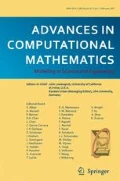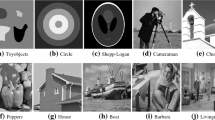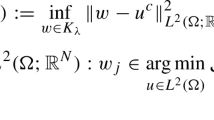Abstract
Nonconvex nonsmooth regularizations have exhibited the ability of restoring images with neat edges in many applications, which has been provided a mathematical explanation by analyzing the discontinuity of the local minimizers of the variational models. Since in many applications the pixel intensity values in digital images are restricted in a certain given range, box constraints are adopted to improve the restorations. A similar property of nonconvex nonsmooth regularization for box-constrained models has been proved in the literature. While many theoretical results are available for anisotropic models, we investigate the isotropic case. We establish similar theoretical results for isotropic nonconvex nonsmooth models with box constraints. Numerical experiments are presented to validate our theoretical results.
Similar content being viewed by others
References
Beck, A., Teboulle, M.: Fast gradient-based algorithms for constrained total variation image denoising and deblurring problems. IEEE Trans. Image Process. 18 (11), 2419–2434 (2009)
Bergmann, R., Chan, R.H., Hielscher, R., Persch, J., Steidl, G.: Restoration of manifold-valued images by half-quadratic minimization. Inverse Probl. Imaging 10(2), 281–304 (2017)
Bian, W., Chen, X.: Linearly constrained non-lipschitz optimization for image restoration. SIAM J. Imag. Sci. 8(4), 2294–2322 (2015)
Bian, W., Chen, X.: Optimality and Complexity for Constrained Optimization Problems with Nonconvex Regularization. Mathematics of Operations Research (2017)
Bondy, J., Murty, U.: Graph theory (graduate texts in mathematics) (2008)
Boyd, S., Parikh, N., Chu, E., Peleato, B., Eckstein, J.: Distributed optimization and statistical learning via the alternating direction method of multipliers. Found. Trends Mach. Learn. 3(1), 1–122 (2011)
Chan, R.H., Tao, M., Yuan, X.: Constrained total variation deblurring models and fast algorithms based on alternating direction method of multipliers. SIAM J. Imag. Sci. 6(1), 680–697 (2013)
Chen, P.Y., Selesnick, I.W.: Group-sparse signal denoising: non-convex regularization, convex optimization. IEEE Trans. Signal Process. 62(13), 3464–3478 (2013)
Chen, X., Ng, M.K., Zhang, C.: Non-Lipschitz-regularization and box constrained model for image restoration. IEEE Trans. Image Process. 21(12), 4709–4721 (2012)
Chen, X., Zhou, W.: Smoothing nonlinear conjugate gradient method for image restoration using nonsmooth nonconvex minimization. SIAM J. Imag. Sci. 3 (4), 765–790 (2010)
Chouzenoux, E., Jezierska, A., Pesquet, J.C., Talbot, H.: A majorize-minimize subspace approach for ℓ 2 − ℓ 0 image regularization. SIAM J. Imag. Sci. 6(1), 563–591 (2013)
Han, Y., Wang, W.W., Feng, X.C.: A new fast multiphase image segmentation algorithm based on nonconvex regularizer. Pattern Recogn. 45(1), 363–372 (2012)
Hanke, M., Nagy, J.G., Vogel, C.: Quasi-Newton approach to nonnegative image restorations. Linear Algebra Appl. 316(1–3), 223–236 (2000)
Hintermüller, M., Wu, T.: Nonconvex TVq -models in image restoration: analysis and a trust-region regularization based superlinearly convergent solver. SIAM J. Imag. Sci. 6(3), 1385–1415 (2013)
Jung, M., Kang, M.: Efficient nonsmooth nonconvex optimization for image restoration and segmentation. J. Sci. Comput. 62(2), 336–370 (2015)
Krishnan, D., Lin, P., Yip, A.M.: A primal-dual active-set method for non-negativity constrained total variation deblurring problems. IEEE Trans. Image Process. 16(11), 2766–2777 (2007)
Nagy, J.G.: Enforcing nonnegativity in image reconstruction algorithms. Proc Spie 4121, 182–190 (2000)
Nikolova, M.: Analysis of the recovery of edges in images and signals by minimizing nonconvex regularized least-squares. Multiscale Model. Simul. 4(3), 960–991 (2005)
Nikolova, M., Ng, M.K., Tam, C.-P.: Fast nonconvex nonsmooth minimization methods for image restoration and reconstruction. IEEE Trans. Image Process. 19 (12), 3073–3088 (2010)
Nikolova, M., Ng, M.K., Tam, C.P.: On ℓ 1 data fitting and concave regularization for image recovery. SIAM J. Scientific Comput. 35(1), A397–A430 (2013)
Nikolova, M., Ng, M.K., Zhang, S., Ching, W.K.: Efficient reconstruction of piecewise constant images using nonsmooth nonconvex minimization. SIAM J. Imag. Sci. 1(1), 2–25 (2008)
Ochs, P., Chen, Y., Brox, T., Pock, T.: ipiano: Inertial proximal algorithm for non-convex optimization. SIAM J. Imag. Sci. 7(2), 1388–1419 (2014)
Ochs, P., Dosovitskiy, A., Brox, T., Pock, T.: On iteratively reweighted algorithms for nonsmooth nonconvex optimization in computer vision. SIAM J. Imag. Sci. 8(1), 331–372 (2015)
Robini, M.C., Yang, F., Zhu, Y.: Inexact half-quadratic optimization for linear inverse problems. SIAM J. Imag. Sci. 11(2), 1078–1133 (2018)
Robini, M.C., Zhu, Y.: Generic half-quadratic optimization for image reconstruction. SIAM J. Imag. Sci. 8(3), 1752–1797 (2015)
Rudin, L.I., Osher, S., Fatemi, E.: Nonlinear total variation based noise removal algorithms. Physica D: Nonlinear Phenomena 60(1), 259–268 (1992)
Weinmann, A., Demaret, L., Storath, M.: Total variation regularization for manifold-valued data. SIAM J. Imag. Sci. 7(4), 2226–2257 (2014)
Wu, C., Liu, Z.-F., Wen, S.: A general truncated regularization framework for contrast-preserving variational signal and image restoration: motivation and implementation. arXiv:1611.08817 (2016)
Wu, C., Tai, X.-C.: Augmented Lagrangian method, dual methods, and split Bregman iteration for ROF, vectorial TV, and high order models. SIAM J. Imag. Sci. 3(3), 300–339 (2010)
Yang, L., Pong, T.K., Chen, X.: Alternating direction method of multipliers for a class of nonconvex and nonsmooth problems with applications to background/foreground extraction. SIAM J. Imag. Sci. 10(1), 74–110 (2017)
Zeng, C., Wu, C.: On the edge recovery property of noncovex nonsmooth regularization in image restoration. SIAM J. Numer. Anal. 56(2), 1168–1182 (2018)
Acknowledgements
The authors would like to thank the anonymous referees for the careful reading of the manuscript and providing valuable suggestions that helped improve this paper. This work is supported by Postdoctoral Science Foundation of China (2016M601248), National Natural Science Foundation of China (Grants 11301289, 11531013 and 11871035), Recruitment Program of Global Young Expert, and the Fundamental Research Funds for the Central Universities.
Author information
Authors and Affiliations
Corresponding author
Additional information
Communicated by: Russell Luke
Appendix The: calculation of the quadratic forms
Appendix The: calculation of the quadratic forms
For any function \(\mathcal {F}(v) \in \mathcal {C}^{2}(\mathbb {R}^{m_{1}})\), our convention of the operator ∇ is \(\nabla \mathcal {F} =(\frac {\partial }{\partial v_{1}} \mathcal {F},\ldots ,\frac {\partial }{\partial v_{m_{1}}} \mathcal {F})^{T}\). Then, the Hessian matrix of F is \(\nabla ^{2} \mathcal {F} =\nabla \nabla ^{T} \mathcal {F}\).
The first and second differentials of \(\mathcal {F}(v)\) at v∗ are well defined and read
where
Notice that u∗ = χ(v∗) and \({G_{i}^{d}} \chi (v) = {g_{i}^{d}} v + {{\Delta }_{i}^{d}}\). We have
It follows that
We have
where
and
where \(\nabla ((G_{i}u^{*})^{T}) = (\nabla ({G_{i}^{x}} u^{*}),\nabla ({G_{i}^{y}} u^{*}))=({{g_{i}^{x}}}^{T},{{g_{i}^{y}}}^{T})={g_{i}^{T}}\). Thus,
At last, we have
Therefore,
For any v ∈ K(I0), any i ∈ I1 ∪ ∂B, we have
It follows that
Rights and permissions
About this article
Cite this article
Zeng, C., Wu, C. On the discontinuity of images recovered by noncovex nonsmooth regularized isotropic models with box constraints. Adv Comput Math 45, 589–610 (2019). https://doi.org/10.1007/s10444-018-9629-1
Received:
Accepted:
Published:
Issue Date:
DOI: https://doi.org/10.1007/s10444-018-9629-1




